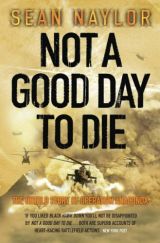Not a Good Day to Die – Book Review
 Book Review: Not A Good Day to Die, Sean Naylor
Book Review: Not A Good Day to Die, Sean Naylor
Berkley Caliber
Sean Naylor’s history of Operation Anaconda is a brilliant recollection of the confusing days leading up to the mission. It is not a treatise on leadership or tactics, nor is it a history. It is both. This book should be on the military’s reading list, from squad leader to Corps commander and beyond.
The book flows from situation to situation in a manner not uncommon to a well-written war novel, with scene changes being easily defined, yet nearly seamless with the line of the story. The characters are developed, some from as early as their basic training, throughout the book, so there are no “flashbacks†breaking the timeline. And although it is incredibly detailed, I never found it to be tedious. It is divided into chapters which are somewhat subdivided into what I would call sections, each section meshed with the chapter, but containing a more complete set of thoughts than a paragraph alone. Most of the time, a section change is defined by a change of the scene or scale from which the operation is reviewed.
{default}Naylor’s book covers both the long run up to Anaconda, as well as the operation itself. It includes every aspect, from local militias trained by Special Forces Commandos, to CIA operations, to regular Army and Air Force units and their involvement. Nearly every aspect of the planning is detailed, showing the successes as well as failures of the multi-service and multi-national team that designed and ran the operation.
This book laid bare many of the failings of America’s military/political system with regards to a 4th Generation (guerilla) war. Sean showed how our politicians desire not to appear to be occupiers crippled our abilities to carry out the operation, by reducing our troop numbers and eliminating the chance of supporting artillery. He showed how an inefficient system of rear area staffers chose an unattached command unit, seemingly at random, to command what was already an almagation of forces. Point after point was devoted to not the lack of intelligence, but the lack of timely intelligence sharing that was the real failing of the command structure. Indeed most of the book is dedicated to this area, which embodied so much of what went wrong. From interpersonal disagreements to interservice rivalries, Mr. Naylor takes you inside each and every major decision of the operation.
But in his covering of what went wrong, he does not forget those that were the victims. The troopers of Task Force Rakkasan, the SEALs of Task Force Blue, and the locally enlisted militias under Texas 14 all fought bravely against overwhelming odds and with inferior planning, and in some cases, equipment. Those valiant soldiers paid the price for the high command’s mistakes, but overcame those mistakes, and persevered to make Operation Anaconda at least a qualified success. This book truly shows the heroism and sacrifices of common men, and the uncommon tenacity they showed against an implacable foe.
This book opened my eyes to issues with our military’s doctrine that I had never though of before. If I were trying to make a definitive treatise on what not to do in war, this book would be a source. I learned the real consequences of taking a cobbled together force and giving it a mission without even allowing it its own integrated supporting arms. I learned what happens when you defy your own principles of warfare in the name of politics and I learned the results of becoming overconfident. In my own opinion, this book should be required reading for anyone desiring to hold a leadership position within today’s military.
For it’s final grade, I’d give this book an A for Content, an A for Depth, an A for Authorship, and an A+ for exposing the internal failings of America’s high command system.

